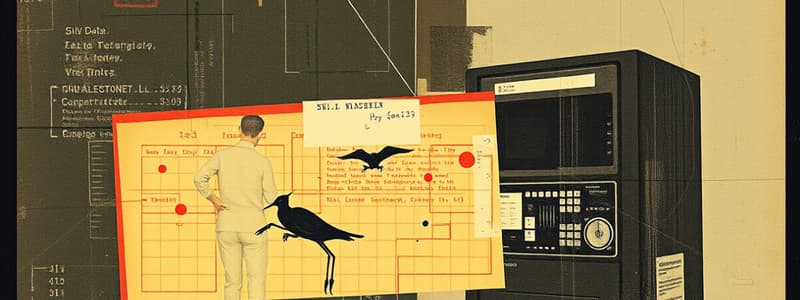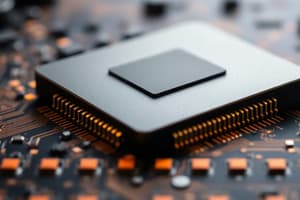Podcast
Questions and Answers
What is the process called when memory is moved from RAM to storage?
What is the process called when memory is moved from RAM to storage?
Swapping out.
When memory is needed again, what is the term for moving it back into RAM?
When memory is needed again, what is the term for moving it back into RAM?
Swapping in.
What methods can an operating system use to allocate swap space on storage devices?
What methods can an operating system use to allocate swap space on storage devices?
A partition or a swap file.
How does dynamic relocation facilitate memory management?
How does dynamic relocation facilitate memory management?
What is a potential result of the excessive swapping process, known as fragmentation?
What is a potential result of the excessive swapping process, known as fragmentation?
What are some common eviction strategies for memory management?
What are some common eviction strategies for memory management?
What role does the operating system play in managing swap space?
What role does the operating system play in managing swap space?
In what situation is a process swapped out of memory?
In what situation is a process swapped out of memory?
What is the primary goal of swapping in operating systems?
What is the primary goal of swapping in operating systems?
Explain how virtual memory complements the swapping technique.
Explain how virtual memory complements the swapping technique.
Define dynamic relocation in the context of memory management.
Define dynamic relocation in the context of memory management.
What is fragmentation, and why is it a concern in memory management?
What is fragmentation, and why is it a concern in memory management?
Describe one common eviction strategy used in memory management.
Describe one common eviction strategy used in memory management.
How do storage devices differ from RAM in terms of their characteristics?
How do storage devices differ from RAM in terms of their characteristics?
What role do caches play in the memory hierarchy of modern computing systems?
What role do caches play in the memory hierarchy of modern computing systems?
Identify a potential drawback of the swapping technique in operating systems.
Identify a potential drawback of the swapping technique in operating systems.
What is meant by 'keeping recently/frequently used processes in RAM'?
What is meant by 'keeping recently/frequently used processes in RAM'?
Explain the significance of memory hierarchy in computer systems.
Explain the significance of memory hierarchy in computer systems.
What is the primary disadvantage of copying data to and from storage when managing RAM for processes?
What is the primary disadvantage of copying data to and from storage when managing RAM for processes?
In the context of multiprocessing, how does hardware support alleviate the costs associated with context switching?
In the context of multiprocessing, how does hardware support alleviate the costs associated with context switching?
What challenges might fragmentation present when scheduling processes and managing RAM?
What challenges might fragmentation present when scheduling processes and managing RAM?
Describe a potential eviction strategy that could be used when managing RAM when memory is under pressure.
Describe a potential eviction strategy that could be used when managing RAM when memory is under pressure.
How do storage devices affect the dynamic relocation of process memory in RAM?
How do storage devices affect the dynamic relocation of process memory in RAM?
What is the primary purpose of memory swapping in operating systems?
What is the primary purpose of memory swapping in operating systems?
Explain dynamic relocation in the context of operating systems.
Explain dynamic relocation in the context of operating systems.
What is fragmentation, and why is it a problem in memory management?
What is fragmentation, and why is it a problem in memory management?
Describe one eviction strategy used in memory management.
Describe one eviction strategy used in memory management.
How do storage devices facilitate memory swapping?
How do storage devices facilitate memory swapping?
What role do device drivers in ROM play in memory management?
What role do device drivers in ROM play in memory management?
What is the naive solution to the problem of context switching between processes?
What is the naive solution to the problem of context switching between processes?
Identify a possible downside of updating an operating system stored in ROM.
Identify a possible downside of updating an operating system stored in ROM.
In systems where both the OS and device drivers are stored in RAM, what challenge does it pose?
In systems where both the OS and device drivers are stored in RAM, what challenge does it pose?
How can using ROM for device drivers enhance the robustness of an embedded system?
How can using ROM for device drivers enhance the robustness of an embedded system?
What memory management technique allows the OS to dynamically change a program's memory space during execution?
What memory management technique allows the OS to dynamically change a program's memory space during execution?
How can fragmentation impact memory usage in an operating system?
How can fragmentation impact memory usage in an operating system?
What is the purpose of memory swapping in an operating system?
What is the purpose of memory swapping in an operating system?
What are eviction strategies in the context of memory management?
What are eviction strategies in the context of memory management?
How does a storage device differ in function from RAM in an operating system?
How does a storage device differ in function from RAM in an operating system?
What was a significant downside of direct physical mapping in early operating systems?
What was a significant downside of direct physical mapping in early operating systems?
In the context of operating systems, what does 'memory abstraction' mean?
In the context of operating systems, what does 'memory abstraction' mean?
Explain how early mainframes managed memory differently from current operating systems.
Explain how early mainframes managed memory differently from current operating systems.
What role do device drivers play in the memory layout of early systems?
What role do device drivers play in the memory layout of early systems?
Identify a key challenge that arises due to the lack of memory protection in systems with direct physical mapping.
Identify a key challenge that arises due to the lack of memory protection in systems with direct physical mapping.
Flashcards are hidden until you start studying
Study Notes
Swapping Technique
- Swapping out refers to transferring unused memory from RAM to storage, while swapping in brings memory back from disk to RAM when needed.
- The operating system reserves a specific area on the storage device for swapping, often implemented as a static partition or dynamic swap file.
Memory Management and Dynamic Relocation
- Multiple processes can coexist in memory; however, physical memory is limited.
- Swapping is a fundamental mechanism used to manage memory, allowing processes to be temporarily stored on disk to free up RAM.
Limited Memory Handling
- Modern systems can run hundreds of processes concurrently, yet they may not all fit in memory simultaneously.
- Solutions to limited memory include swapping and virtual memory, which leverage the hierarchy of memory types, balancing speed and cost.
- Fast memory includes RAM and caches, while slow memory encompasses storage devices (HDDs, SSDs).
Swapping in Embedded Systems
- Swapping techniques are utilized in some embedded devices where resource constraints are present.
- Device drivers can be stored in ROM, providing protection to the operating system, which may reside in RAM and can be updated.
Early Memory Management
- Before the 1980s, programs directly interacted with physical memory, using hard-coded addresses for memory access.
- This environment limited memory management and process isolation, hindering the execution of multiple processes simultaneously.
Memory Layouts with Direct Mapping
- The simple layout involved all processes being mapped within RAM, risking exposure of the OS memory to user applications.
- Other configurations include:
- The OS stored in ROM to protect it from user programs, which prevented updates or extensions.
- Memory copying between storage and RAM incurs performance costs and is inefficient for multi-core systems.
Context Switching in Multiprocessing
- To switch between processes, the memory of the currently active process is transferred to storage, with the new process's memory then loading into RAM.
- This naive approach can lead to significant delays due to the costs of moving data between RAM and storage.
Hardware Memory Support
- Hardware support can minimize context switching costs and enhance performance in multi-core systems, allowing for more efficient memory management.
Studying That Suits You
Use AI to generate personalized quizzes and flashcards to suit your learning preferences.




